A New Explanation for the Effect of Dynamic Strain Aging on Negative Strain Rate Sensitivity in Fe–30Mn–9Al–1C Steel
Abstract
:1. Introduction
2. Materials and Methods
3. Results and Discussion
3.1. Evolution of Mechanical Properties
3.2. Microstructure Characteristics
3.3. Fracture Feature
3.4. Analysis of the Dislocation Interaction
3.5. Influence of Adiabatic Heating
4. Conclusions
Author Contributions
Funding
Conflicts of Interest
References
- Xing, J.; Wei, Y.; Hou, L. An overview of the effects of alloying elements on the properties of lightweight Fe–(15–35) Mn–(5–12) Al–(0.3–1.2) C steel. JOM 2018, 70, 929–937. [Google Scholar] [CrossRef]
- Yoo, J.D.; Park, K.T. Microband-induced plasticity in a high Mn–Al–C light steel. Mater. Sci. Eng. A 2008, 496, 417–424. [Google Scholar] [CrossRef]
- Hamada, A.S.; Kisko, A.; Khosravifard, A.; Hassan, M.A.; Karjalainen, L.P.; Porter, D. Ductility and formability of three high-Mn TWIP steels in quasi-static and high-speed tensile and Erichsen tests. Mater. Sci. Eng. A 2018, 712, 255–265. [Google Scholar] [CrossRef]
- Hwang, S.W.; Ji, J.H.; Park, K.-T. Effects of Al addition on high strain rate deformation of fully austenitic high Mn steels. Mater. Sci. Eng. A 2011, 528, 7267–7275. [Google Scholar] [CrossRef]
- Yao, M.J.; Welsch, E.; Ponge, D.; Haghighat, S.M.H.; Sandlöbes, S.; Choi, P.; Herbig, M.; Bleskov, I.; Hickel, T.; Lipinska-Chwalek, M.; et al. Strengthening and strain hardening mechanisms in a precipitation-hardened high-Mn lightweight steel. Acta Mater. 2017, 140, 258–273. [Google Scholar] [CrossRef]
- Moon, J.; Park, S.J.; Lee, C.; Han, H.N.; Lee, T.H.; Lee, C.H. Microstructure Evolution and Age-Hardening Behavior of Microalloyed Austenitic Fe-30Mn-9Al-0.9C Light-Weight Steels. Metall. Mater. Trans. A 2017, 48A, 4500–4510. [Google Scholar] [CrossRef]
- Haase, C.; Zehnder, C.; Ingendahl, T.; Bikar, A.; Tang, F.; Hallstedt, B.; Hu, W.; Bleck, W.; Molodov, D.A. On the deformation behavior of κ-carbide-free and κ-carbide-containing high-Mn light-weight steel. Acta Mater. 2017, 122, 332–343. [Google Scholar] [CrossRef]
- Zavattieri, P.D.; Savic, V.; Hector, L.G.; Fekete, J.R.; Tong, W.; Xuan, Y. Spatio-temporal characteristics of the Portevin–Le Châtelier effect in austenitic steel with twinning induced plasticity. Int. J. Plast. 2009, 25, 2298–2330. [Google Scholar] [CrossRef]
- Callahan, M.; Perlade, A.; Schmitt, J.-H. Interactions of negative strain rate sensitivity, martensite transformation, and dynamic strain aging in 3rd generation advanced high-strength steels. Mater. Sci. Eng. A 2019, 754, 140–151. [Google Scholar] [CrossRef]
- Lee, S.-Y.; Hwang, B. Dynamic Strain Aging and Serration Behavior of Three High-Manganese Austenitic Steels. Metall. Mater. Trans. A 2019, 50, 1693–1700. [Google Scholar] [CrossRef]
- Cottrell, A.H. Theory of Brittle Fracture in Steel and Similar Metals. Trans. Metall. Soc. AIME 1958, 212, 192–202. [Google Scholar]
- Van Den Beukel, A. Theory of the effect of dynamic strain aging on mechanical properties. Phys. Status Solidi A 1975, 30, 197–206. [Google Scholar] [CrossRef]
- Lee, S.-J.; Kim, J.; Kane, S.N.; Cooman, B.C.D. On the origin of dynamic strain aging in twinning-induced plasticity steels. Acta Mater. 2011, 59, 6809–6819. [Google Scholar] [CrossRef]
- Lan, P.; Zhang, J. Serrated Flow and Dynamic Strain Aging in Fe-Mn-C TWIP Steel. Metall. Mater. Trans. A 2018, 49, 147–161. [Google Scholar] [CrossRef]
- Kim, J.; Lee, S.-J.; De Cooman, B.C. Effect of Al on the stacking fault energy of Fe–18Mn–0.6C twinning-induced plasticity. Scr. Mater. 2011, 65, 363–366. [Google Scholar] [CrossRef]
- Picu, R.C. A mechanism for the negative strain-rate sensitivity of dilute solid solutions. Acta Mater. 2004, 52, 3447–3458. [Google Scholar] [CrossRef]
- Rose, K.S.B.; Gloverj, S.G. A study of strain-ageing in austenite. Acta Metall. 1966, 14, 1505–1516. [Google Scholar] [CrossRef]
- Meyers, M.A. Dynamic Behavior of Materials; John Wiley & Sons: Hoboken, NY, USA, 1994; p. 324. [Google Scholar]
- Liang, Z.Y.; Wang, X.; Huang, W.; Huang, M.X. Strain rate sensitivity and evolution of dislocations and twins in a twinning-induced plasticity steel. Acta Mater. 2015, 88, 170–179. [Google Scholar] [CrossRef]
- Sun, T.; Wan, C.M.; Byrne, J.G. A study of work hardening in austenitic Fe-Mn-Al-C and Fe-Mn-Al-C alloys. Acta Metall. Mater. 1992, 40, 3407–3412. [Google Scholar] [CrossRef]
- Liang, Z.Y.; Huang, W.; Huang, M.X. Suppression of dislocations at high strain rate deformation in a twinning-induced plasticity steel. Mater. Sci. Eng. A 2015, 628, 84–88. [Google Scholar] [CrossRef]
- Mulford, R.A.; Kocks, U.F. New observations on the mechanisms of dynamic strain aging and of jerky flow. Acta Metall. 1979, 27, 1125–1134. [Google Scholar] [CrossRef]
- Xing, J.; Hou, L.; Du, H.; Liu, B.; Wei, Y. Effects of Pre-deformation on the Kinetics of β-Mn Phase Precipitation and Mechanical Properties in Fe–30Mn–9Al–1C Lightweight Steel. Metall. Mater. Trans. A 2019, 50, 2629–2639. [Google Scholar] [CrossRef]
- Choi, K.; Seo, C.H.; Lee, H.; Kim, S.K.; Kwak, J.H.; Chin, K.G.; Park, K.T.; Kim, N.J. Effect of aging on the microstructure and deformation behavior of austenite base lightweight Fe–28Mn–9Al–0.8C steel. Scr. Mater. 2010, 63, 1028–1031. [Google Scholar] [CrossRef]
- Vaynman, S.; Fine, M.E.; Lee, S.; Espinosa, H.D. Effect of strain rate and temperature on mechanical properties and fracture mode of high strength precipitation hardened ferritic steels. Scr. Mater. 2006, 55, 351–354. [Google Scholar] [CrossRef]
- Choudhary, B.K. Influence of Strain Rate and Temperature on Tensile Deformation and Fracture Behavior of Type 316L(N) Austenitic Stainless Steel. Metall. Mater. Trans. A 2013, 45, 302–316. [Google Scholar] [CrossRef]
- Khodabakhshi, F.; Farshidianfar, M.H.; Gerlich, A.P.; Nosko, M.; Trembošová, V.; Khajepour, A. Microstructure, strain-rate sensitivity, work hardening, and fracture behavior of laser additive manufactured austenitic and martensitic stainless steel structures. Mater. Sci. Eng. A 2019, 756, 545–561. [Google Scholar] [CrossRef]
- Irwin, G.R. Analysis of stresses and strains near the end of cracking traversing a plate. J. Appl. Mech. 1957, 24, 361–364. [Google Scholar]
- Ast, J.; Ghidelli, M.; Durst, K.; Göken, M.; Sebastiani, M.; Korsunsky, A.M. A review of experimental approaches to fracture toughness evaluation at the micro-scale. Mater. Des. 2019, 173, 107762. [Google Scholar] [CrossRef]
- Kupka, D.; Lilleodden, E.T. Mechanical Testing of Solid–Solid Interfaces at the Microscale. Exp. Mech. 2012, 52, 649–658. [Google Scholar] [CrossRef]
- Yin, F.X.; Xia, H.; Feng, J.H.; Cai, M.H.; Zhang, X.; Wang, G.K.; Sawaguchi, T. Mechanical properties of an Fe-30Mn-4Si-2Al alloy after rolling at different temperatures ranging from 298 to 1073 K. Mater. Sci. Eng. A 2018, 725, 127–137. [Google Scholar] [CrossRef]
- Ungár, T.; Ott, S.; Sanders, P.G.; Borbély, A.; Weertman, J.R. Dislocations, grain size and planar faults in nanostructured copper determined by high resolution X-ray diffraction and a new procedure of peak profile analysis. Acta Mater. 1998, 46, 3693–3699. [Google Scholar] [CrossRef]
- Shintani, T.; Murata, Y. Evaluation of the dislocation density and dislocation character in cold rolled Type 304 steel determined by profile analysis of X-ray diffraction. Acta Mater. 2011, 59, 4314–4322. [Google Scholar] [CrossRef]
- Ungar, T.; Dragomir, I.; Revesz, A.; Borbely, A. The contrast factors of dislocations in cubic crystals: The dislocation model of strain anisotropy in practice. J. Appl. Crystallogr. 1999, 32, 992–1002. [Google Scholar] [CrossRef]
- Das, T.; Saha, R.; Bera, S.; Dahmen, K.; Ghosh, M.; Haldar, A.; Bleck, W.; Chowdhury, S.G. Effect of High Tensile Strain Rate on the Evolution of Microstructure in Fe-Mn-C-Al Twinning-Induced Plasticity (TWIP) Steel. Metall. Mater. Trans. A 2015, 46, 6–11. [Google Scholar] [CrossRef]
- Ungar, T.; Mughrabi, H.; Rönnpagel, D.; Wilkens, M. X-ray line-broadening study of the dislocation cell structure in deformed [001]-orientated copper single crystals. Acta Metall. 1984, 32, 333–342. [Google Scholar] [CrossRef]
- Okamoto, S.; Matlock, D.K.; Krauss, G. The transition from serrated to non-serrated flow in low-carbon martensite at 150 °C. Scr. Metall. Mater. 1991, 25, 39–44. [Google Scholar] [CrossRef]
- Park, J.; Kang, M.; Sohn, S.S.; Kim, S.-H.; Kim, H.S.; Kim, N.J.; Lee, S. Quasi-static and dynamic deformation mechanisms interpreted by microstructural evolution in TWinning Induced Plasticity (TWIP) steel. Mater. Sci. Eng. A 2017, 684, 54–63. [Google Scholar] [CrossRef]
- Khosravifard, A.; Moshksar, M.M.; Ebrahimi, R. High strain rate torsional testing of a high manganese steel: Design and simulation. Mater. Des. 2013, 52, 495–503. [Google Scholar] [CrossRef]
- Curtze, S.; Kuokkala, V.T. Dependence of tensile deformation behavior of TWIP steels on stacking fault energy, temperature and strain rate. Acta Mater. 2010, 58, 5129–5141. [Google Scholar] [CrossRef]
- Choudhary, B.K.; Christopher, J. Influence of temperature and strain rate on tensile deformation and fracture behaviour of boron added P91 steel. Int. J. Press. Vessel. Pip. 2019, 171, 153–161. [Google Scholar] [CrossRef]
- Han, G.W.; Jones, I.P.; Smallman, R.E. Direct evidence for Suzuki segregation and Cottrell pinning in MP159 superalloy obtained by FEG(S)TEM/EDX. Acta Mater. 2003, 51, 2731–2742. [Google Scholar] [CrossRef]
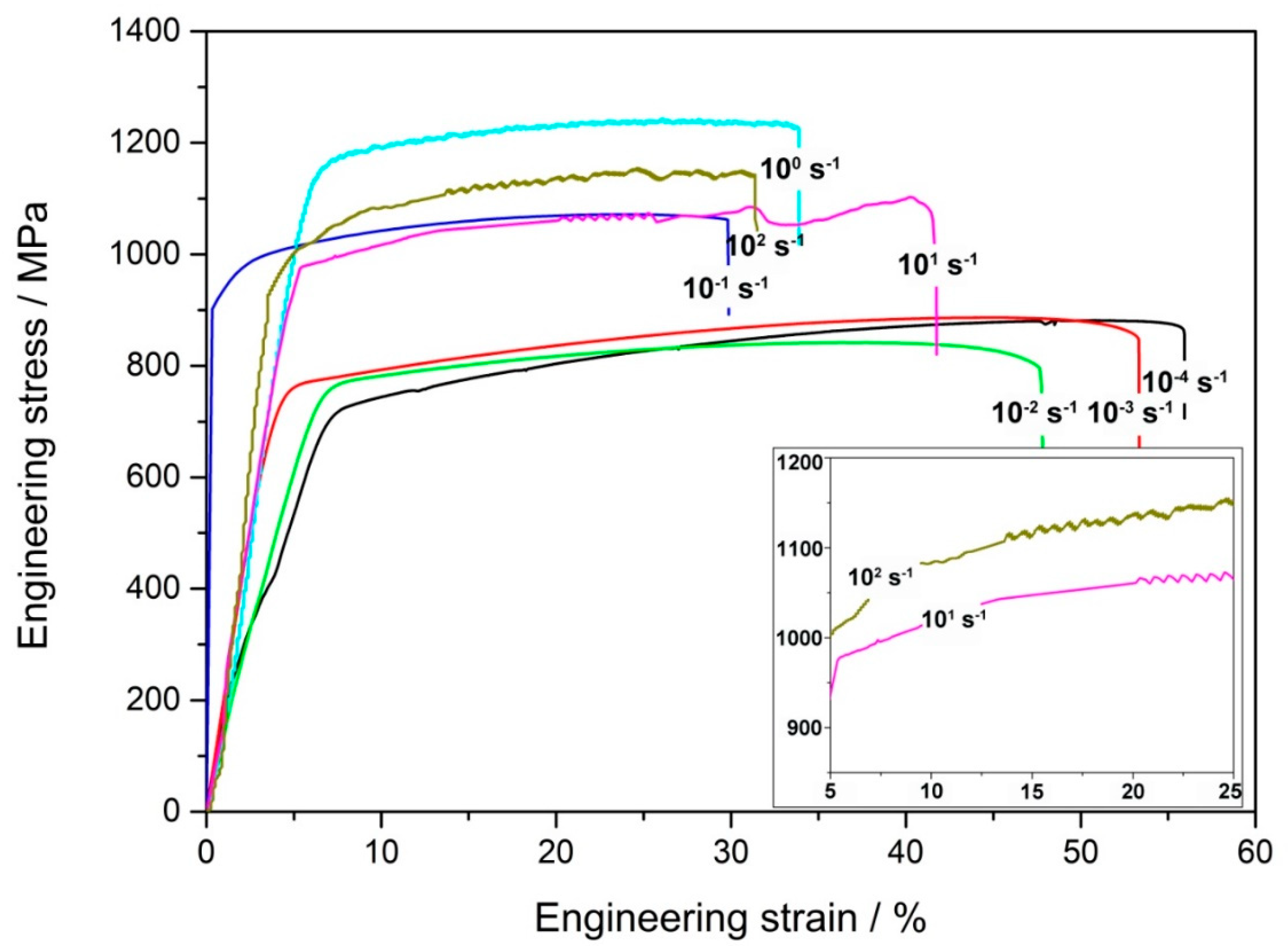
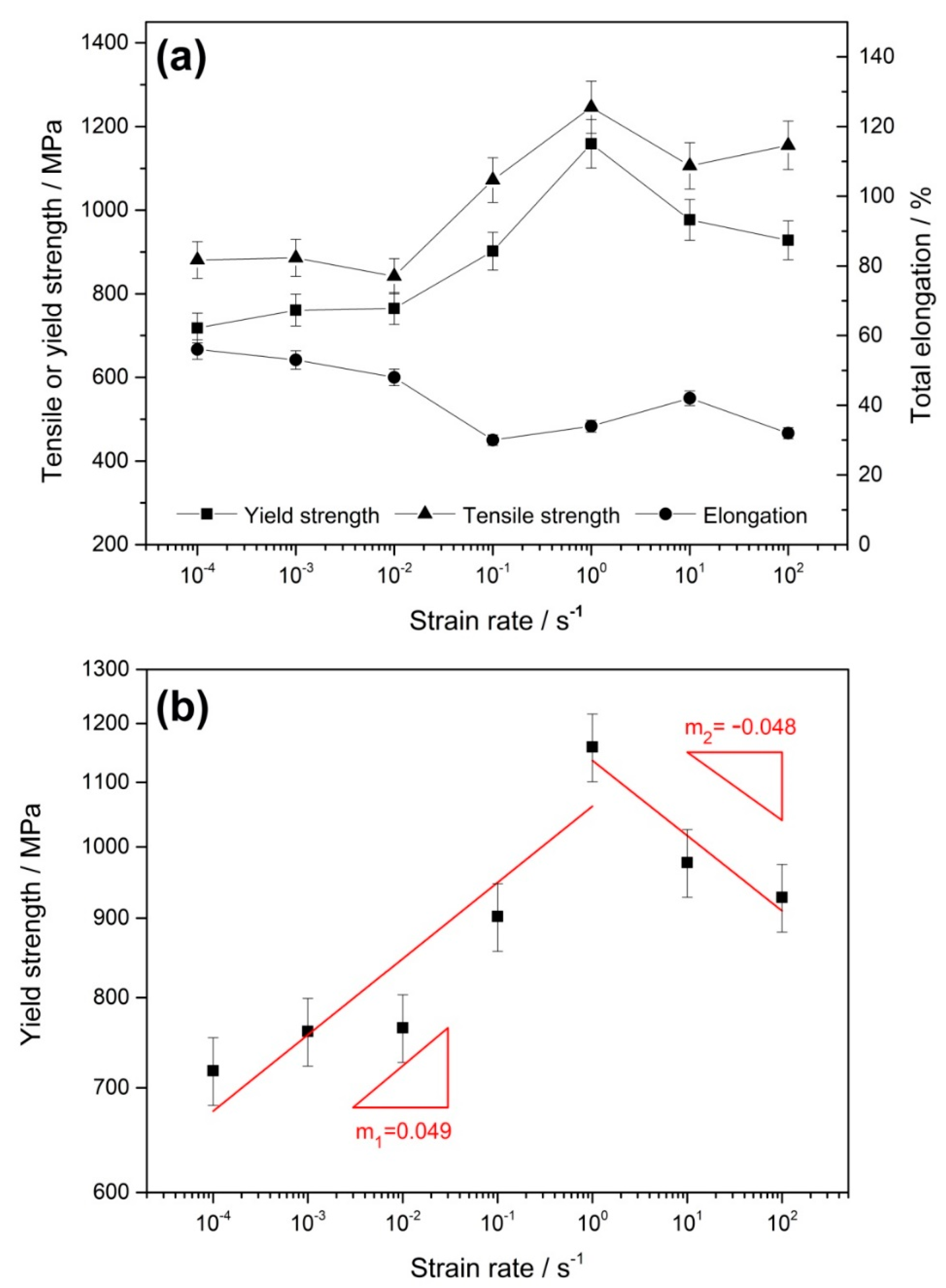
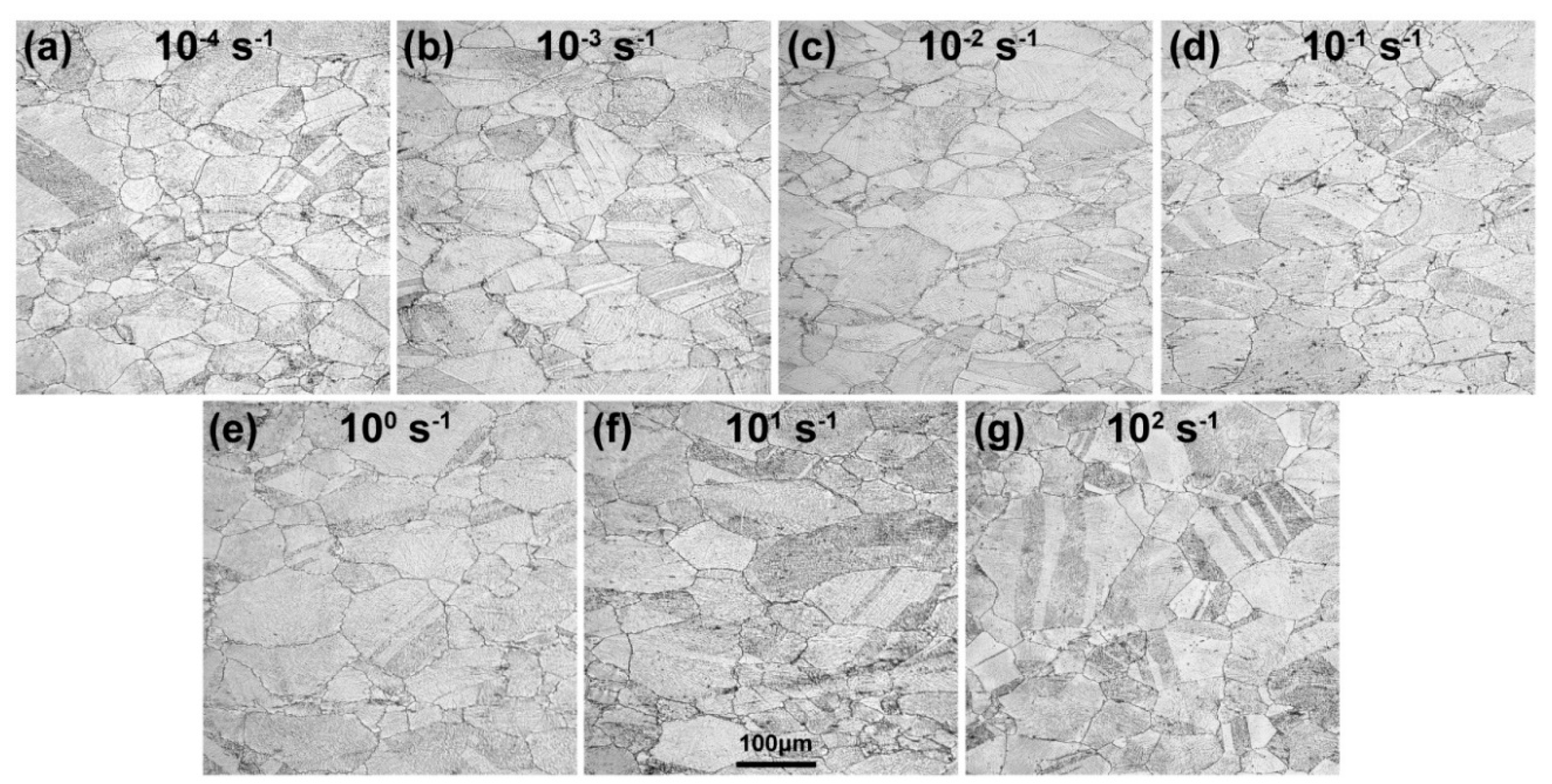
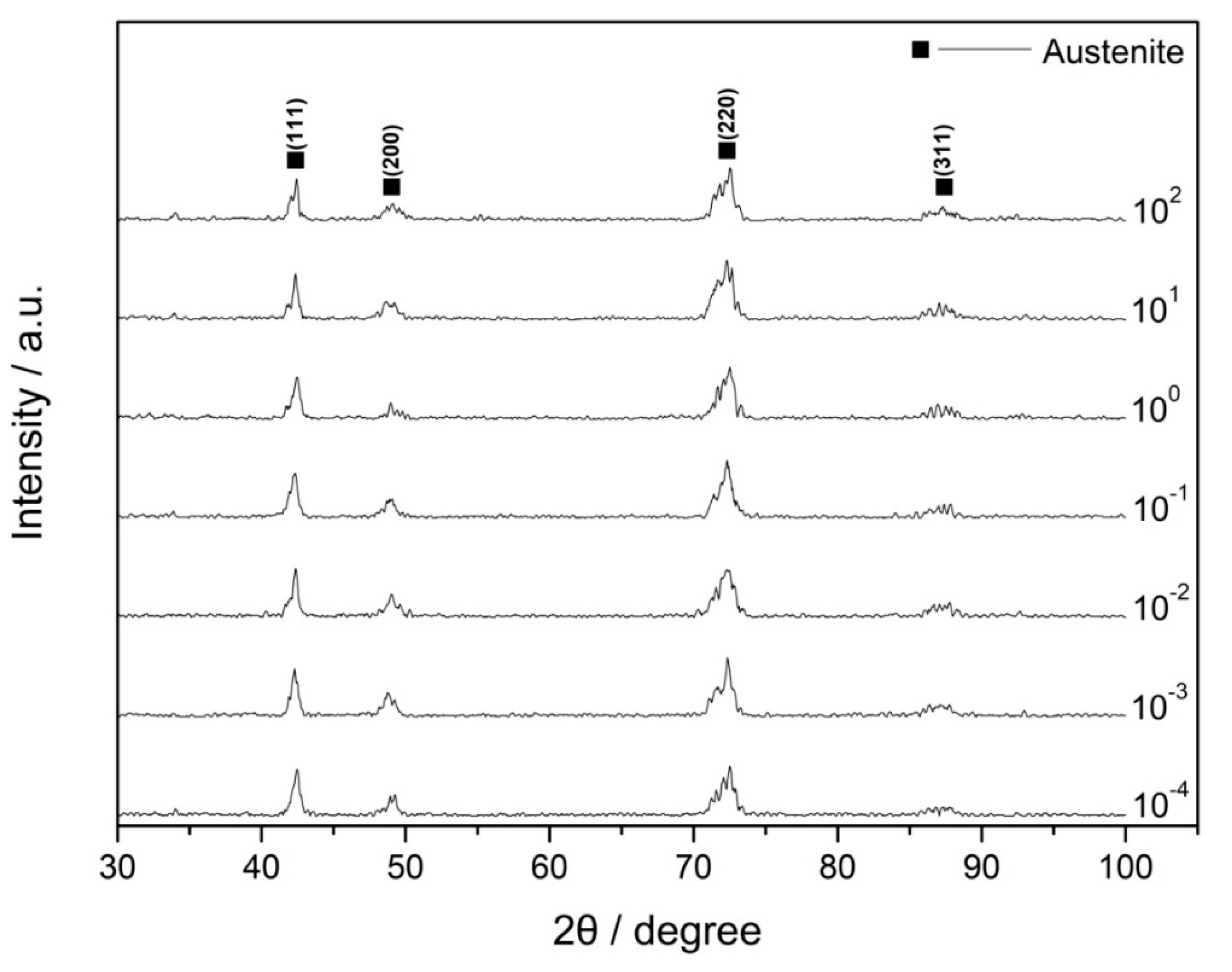
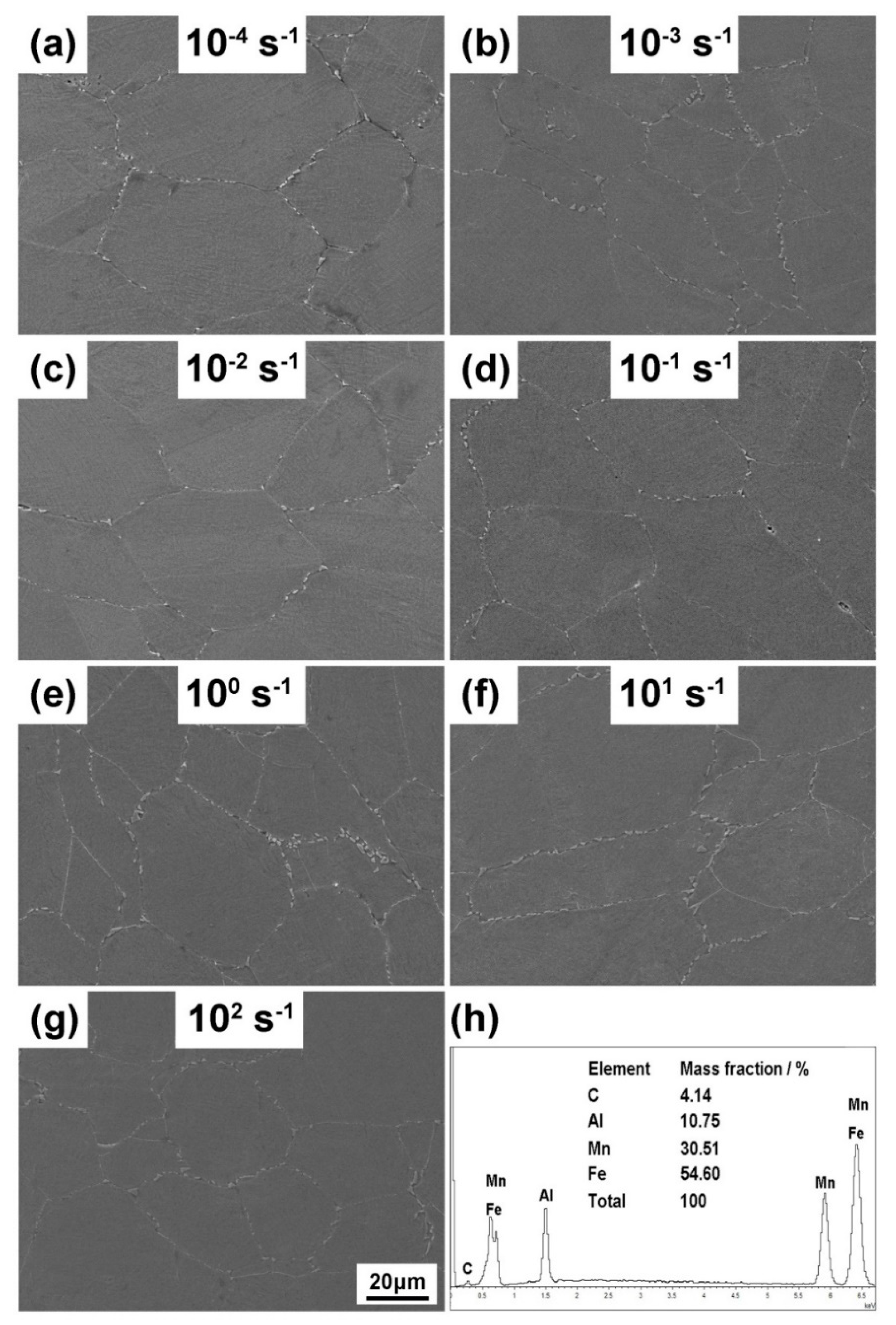
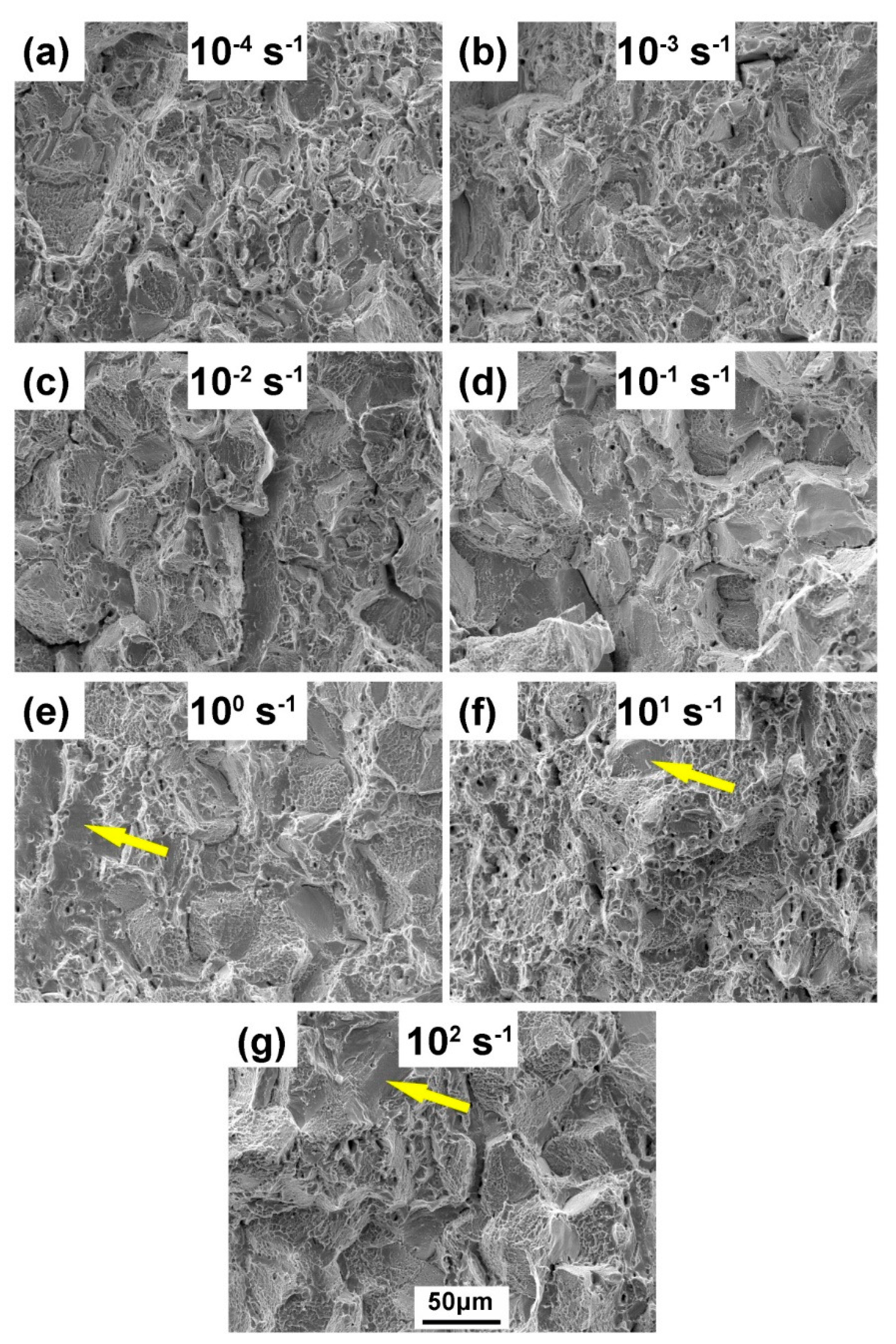
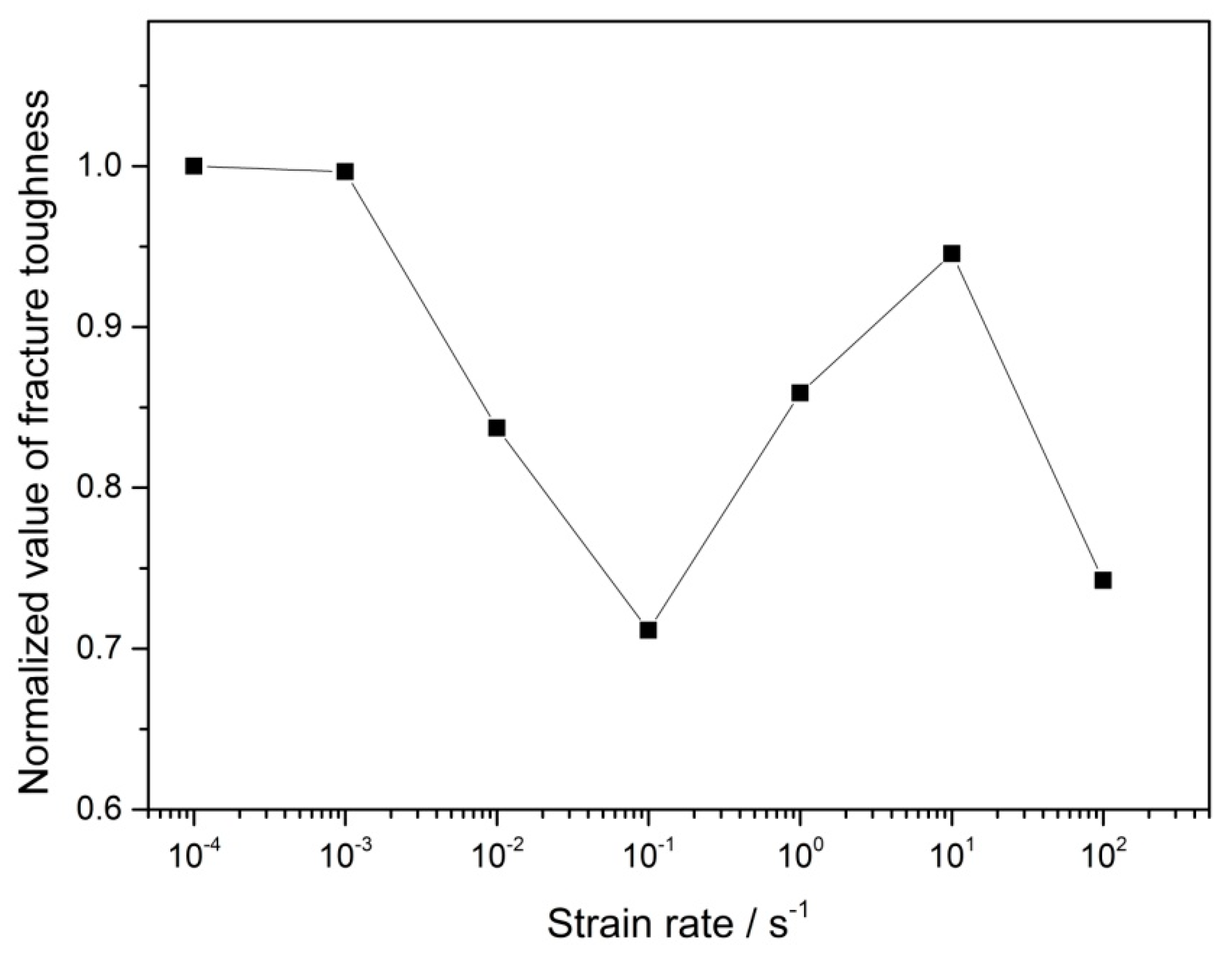
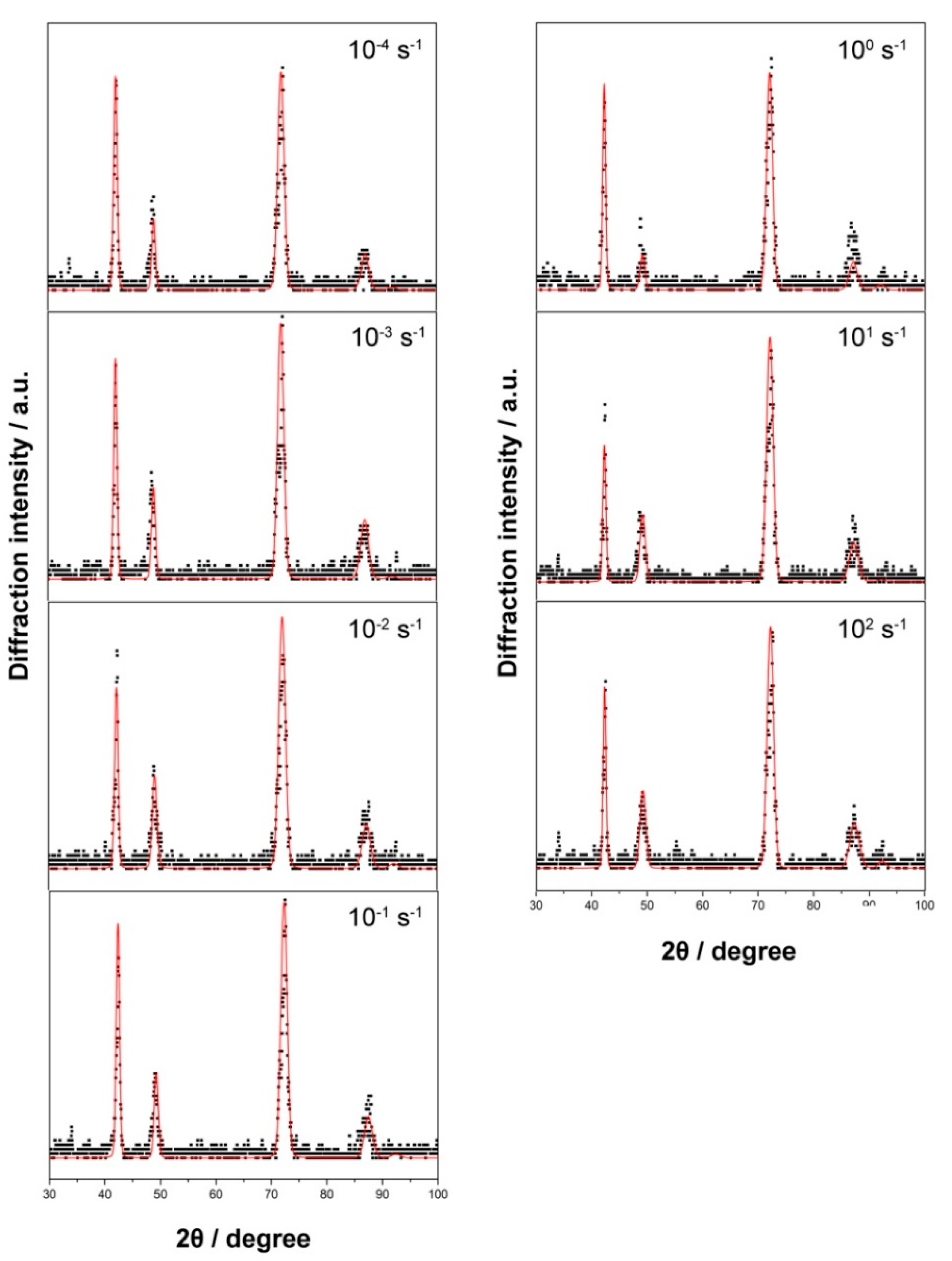
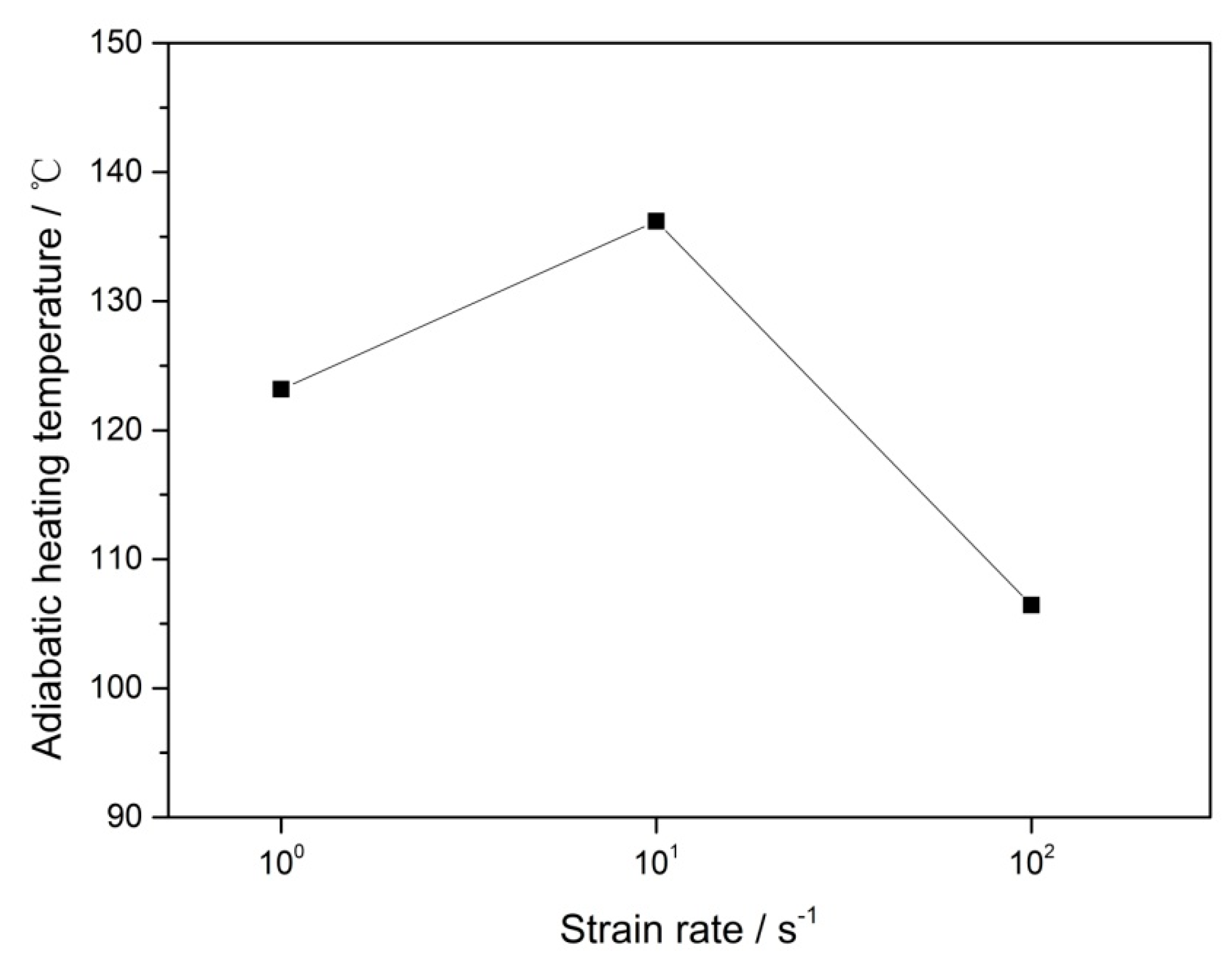
| Strain Rate/s−1 | D × 10−9/m | ρ/m−2 | M | q | |
|---|---|---|---|---|---|
| 10−4 | 0.0060 | 94.234 | 1.87 × 1015 | 2.48 | 2.45 |
| 10−3 | 0.0062 | 139.360 | 1.30 × 1015 | 3.28 | 2.04 |
| 10−2 | 0.0048 | 58.011 | 2.29 × 1015 | 3.28 | 2.40 |
| 10−1 | 0.0063 | 94.650 | 1.93 × 1015 | 3.79 | 2.26 |
| 100 | 0.0060 | 85.743 | 2.04 × 1015 | 4.37 | 2.33 |
| 101 | 0.0070 | 135.148 | 1.51 × 1015 | 5.69 | 2.38 |
| 102 | 0.0069 | 120.827 | 1.66 × 1015 | 5.65 | 2.45 |
© 2019 by the authors. Licensee MDPI, Basel, Switzerland. This article is an open access article distributed under the terms and conditions of the Creative Commons Attribution (CC BY) license (http://creativecommons.org/licenses/by/4.0/).
Share and Cite
Xing, J.; Hou, L.; Du, H.; Liu, B.; Wei, Y. A New Explanation for the Effect of Dynamic Strain Aging on Negative Strain Rate Sensitivity in Fe–30Mn–9Al–1C Steel. Materials 2019, 12, 3426. https://doi.org/10.3390/ma12203426
Xing J, Hou L, Du H, Liu B, Wei Y. A New Explanation for the Effect of Dynamic Strain Aging on Negative Strain Rate Sensitivity in Fe–30Mn–9Al–1C Steel. Materials. 2019; 12(20):3426. https://doi.org/10.3390/ma12203426
Chicago/Turabian StyleXing, Jia, Lifeng Hou, Huayun Du, Baosheng Liu, and Yinghui Wei. 2019. "A New Explanation for the Effect of Dynamic Strain Aging on Negative Strain Rate Sensitivity in Fe–30Mn–9Al–1C Steel" Materials 12, no. 20: 3426. https://doi.org/10.3390/ma12203426
APA StyleXing, J., Hou, L., Du, H., Liu, B., & Wei, Y. (2019). A New Explanation for the Effect of Dynamic Strain Aging on Negative Strain Rate Sensitivity in Fe–30Mn–9Al–1C Steel. Materials, 12(20), 3426. https://doi.org/10.3390/ma12203426




